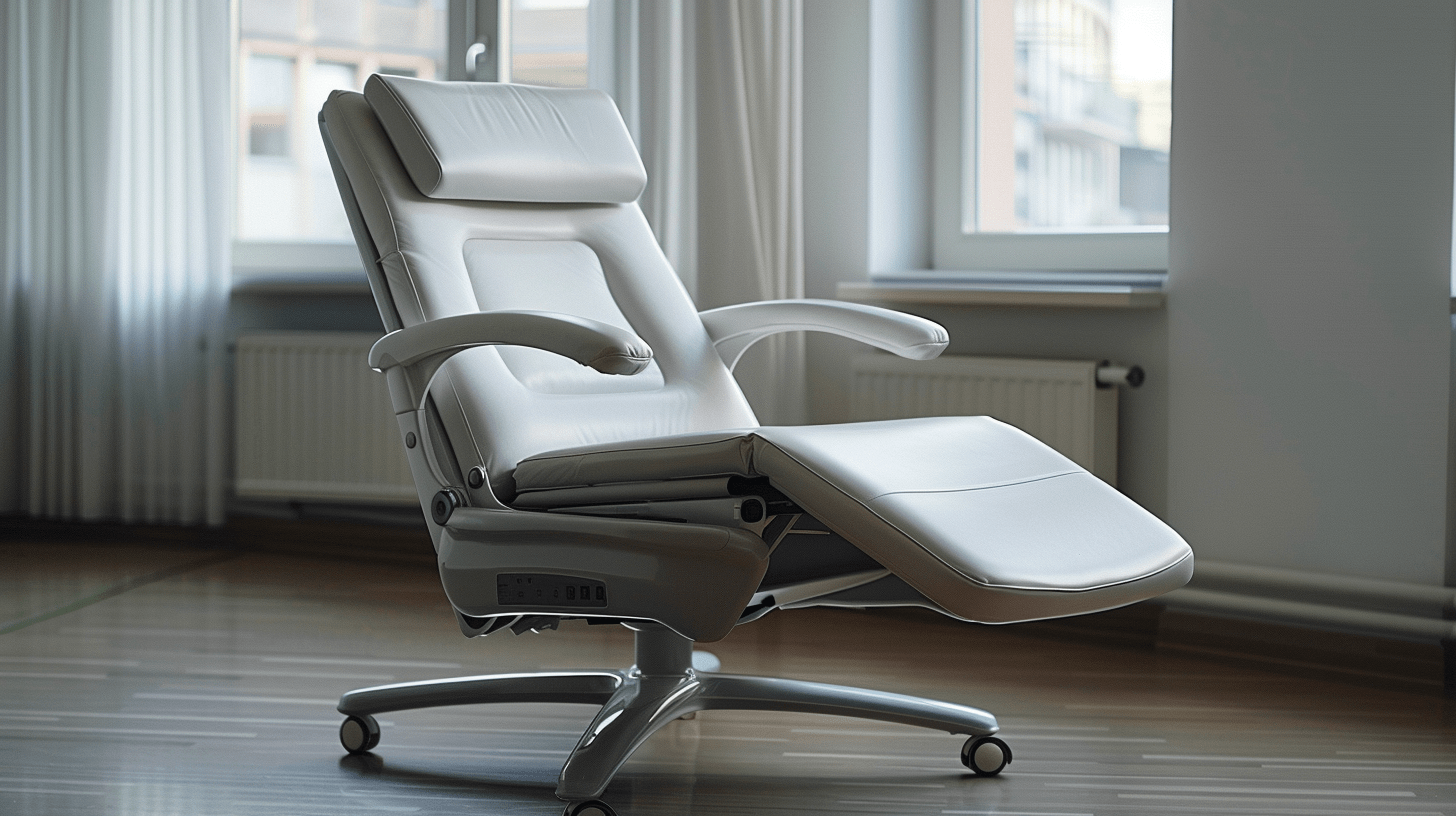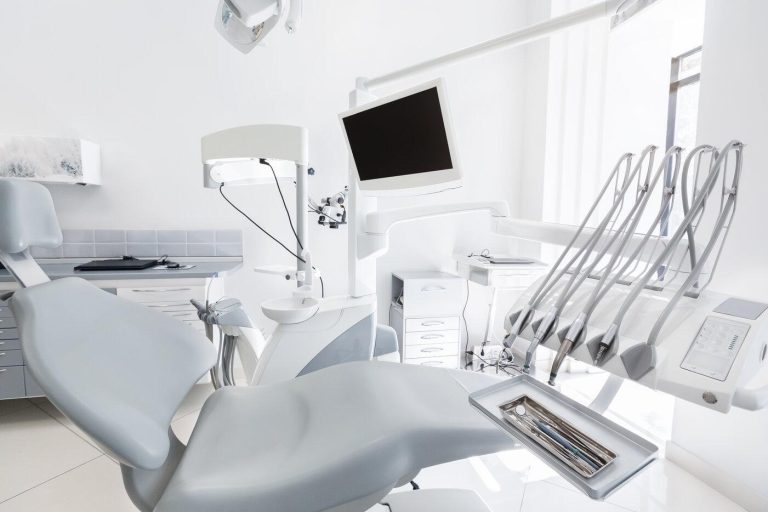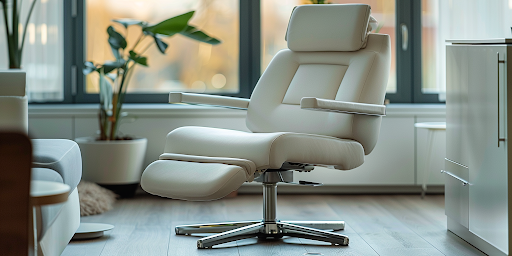Clinical chairs, integral to healthcare environments, are designed with various safety features to enhance patient comfort, reduce risks, and accommodate diverse medical needs. These chairs are meticulously engineered to empower users with limited mobility, providing ergonomic and functional support. In this article, we explain the key safety features of clinical chairs that make them indispensable in healthcare settings.
Are You Interested in Investing in Clinical Chairs?
At EMP Living, our mission is to provide functional and ergonomic seating that empowers users to do more independently and safely, whether at home, work, or school. We specialize in both powered and manual adaptive seating with designs crafted to adapt, providing comfort, safety, and functionality for various personal and medical needs. EMP Living offers adaptive seating for clinical environments, including specialized chairs for X-rays, mammography exams, and more. These chairs are designed to accommodate patients with mobility challenges.
Why EMP Living?
Choosing EMP Living means selecting adaptive seating solutions that prioritize user experience, functional design, and therapeutic benefits. Our chairs are developed with input from healthcare professionals to ensure optimal support and comfort.
Explore our range of powered clinical chairs
Comfort and Ergonomics: Key Safety Features of Medical Chairs
Clinical chairs boast a range of key safety features, such as adjustable bodies and increased weight limits. These modifications help accommodate all types of users, ensuring a personalized fit that enhances comfort and safety.
Durable Materials
Quality Materials
Clinical chairs are constructed from high-quality materials, such as durable metals and density polypropylene skid plates, ensuring longevity and resistance to wear and tear. This durability is essential for maintaining safety over extended periods of use.
Infection Control
Materials used in these chairs are also selected for their ease of cleaning, playing a crucial role in infection control. Healthcare facilities can reduce the risk of infection by regularly maintaining and disinfecting the chairs with a damp cloth.
Enhanced Mobility and Stability
Mobility and Weight Capacity
Chairs designed for patients with mobility issues feature advanced technology to facilitate smooth movements. The weight capacity of these chairs is carefully considered to support different body weights, ensuring stability and preventing accidents.
Brakes on Wheels
A significant safety feature in clinical chairs is the inclusion of brakes on wheels. These brakes keep the chair stationary during patient transfer or treatment, significantly reducing the risk of falls and injuries.
Restraint and Security
Secure Restraint Systems
In behavioral health and acute care settings, secure restraint systems, such as soft restraint straps, nylon ankle straps, and nylon wrist straps, are essential. These features ensure patient safety during intense treatments or when dealing with anxiety in patients.
Quick Release Mechanisms
Quick release mechanisms on shoulder harness straps and other restraints provide an additional layer of safety, allowing healthcare professionals to promptly release the patient if needed.
Adjustable Features Customizable to Patient Needs
Height Adjustable Chairs
Pneumatic height adjustment and other customizable features enable clinical chairs to cater to a variety of patient heights and body types, including pregnant users. This adaptability ensures the chair can meet the specific needs of each patient, promoting comfort and safety.
Pressure Management
To prevent excess pressure during sessions, clinical chairs are equipped with features that distribute weight evenly, supporting healthy blood flow and reducing the risk of pressure injuries.
Independence at Home | Can Clinical Chairs Be Used for Home Care?
How Do Medical Care Chairs Simplify Treatment?
Clinical chairs are designed to simplify patient care by enhancing comfort, safety, and accessibility. Their advanced features and ergonomic design help healthcare professionals provide better care while reducing the physical strain on both patients and caregivers.
Enhanced Comfort and Support
- Ergonomic Design: Clinical chairs are designed with ergonomics in mind, providing optimal support for the patient’s body. Features like adjustable headrests, armrests, and footrests ensure that patients can sit comfortably for extended periods, which is crucial during lengthy medical procedures or treatments.
- Pressure Management: Clinical chairs incorporate pressure-relieving cushions and materials that help distribute the patient’s weight evenly, preventing pressure sores and discomfort. This is especially important for patients who are immobile or have limited mobility.
Versatile Adjustability
- Height and Tilt Adjustability: Clinical chairs feature height and tilt adjustments, allowing healthcare providers to position patients at the optimal height and angle for various procedures. Pneumatic height adjustment mechanisms enable smooth and easy changes in position, accommodating the needs of different patients and medical tasks.
- Customized Fit: With adjustable components, clinical chairs can be tailored to fit patients of varying sizes and body types, including shorter users, taller users, and pregnant users. This customization enhances patient comfort and ensures proper support.
Facilitating Mobility and Transfers
- Power Assistance: Powered clinical chairs offer functions such as motorized adjustments for height, tilt, and backrest positions. These features help patients move from sitting to standing positions more easily and independently, reducing the need for manual lifting by caregivers.
- Transfer Support: Clinical chairs include features like footplates and armrests that can be moved or removed to facilitate easier transfers. This is particularly beneficial for wheelchair users and individuals with mobility challenges, allowing for smoother transitions between different seating and lying positions.
Efficiency in Clinical Settings
- Quick Adjustments: The ability to quickly and easily adjust the chair’s settings allows healthcare providers to spend more time focusing on patient care rather than manual adjustments. This efficiency can improve the workflow in busy clinical environments.
- Versatility: Clinical chairs can be used in various medical settings, from examination rooms to treatment areas, making them a versatile piece of equipment. They can be adapted for different medical procedures, reducing the need for multiple types of seating equipment.
Supporting Patient Well-being
- Reducing Anxiety: Comfortable and secure seating can help reduce patient anxiety during medical procedures. Features like gentle movement adjustments and soft cushioning contribute to a more relaxing environment, which can be particularly beneficial for patients with dental anxiety or other medical-related fears.
- Promoting Independence: Features such as power-assisted adjustments and easy-to-use controls empower patients to make their own adjustments, fostering a sense of independence and control over their environment.
Simplified Maintenance and Hygiene
- Easy-to-Clean Materials: Clinical chairs are made from materials that are easy to clean and disinfect, helping to maintain hygiene standards in healthcare facilities. Regular cleaning and maintenance ensure that the chairs remain safe and sanitary for patient use.
- Durability: Built with high-quality, durable materials, clinical chairs are designed to withstand the rigors of daily use in healthcare settings. This durability reduces the need for frequent replacements and repairs, ensuring that the chairs remain reliable over time.
What Are Clinical Chairs Used For?
Ensuring Long-term Safety: Regular Maintenance of Medical Seating Solutions
Regular maintenance is vital to ensure the safety and functionality of clinical chairs. Adhering to a maintenance schedule helps identify and address potential hazards, ensuring the equipment remains in optimal condition.
Maintenance Requirements
- Inspection Schedule: Establishing a routine inspection schedule is key. Regular inspections help identify wear and tear, loose components, or any other issues that could compromise the chair’s safety and performance. These inspections should be conducted by trained personnel who can recognize and address potential problems promptly.
- Preventive Maintenance: Preventive maintenance involves routine servicing of the chair’s mechanical and electrical components to prevent breakdowns. This includes checking the integrity of power cords, ensuring that all moving parts are lubricated, and verifying that adjustment mechanisms are working smoothly.
- Manufacturer’s Guidelines: Adherence to the manufacturer’s maintenance guidelines is essential. These guidelines provide specific instructions on how often maintenance should be performed and which components need regular attention. Following these recommendations helps maintain the chair’s warranty and ensures it operates safely.
- Record Keeping: Maintaining detailed records of all maintenance activities is vital. This includes noting the date of inspections, parts replaced, and any repairs carried out. Comprehensive records help track the chair’s condition over time and identify recurring issues that may require more permanent solutions.
Cleaning and Care
Proper cleaning and care practices are equally important in maintaining the safety and hygiene of clinical chairs. Here’s how to ensure that chairs remain in top condition:
- Regular Cleaning: Clinical chairs should be cleaned regularly to remove dust, dirt, and biological contaminants. This is especially important in healthcare environments where hygiene is critical. Use appropriate cleaning agents that are effective against bacteria and viruses but gentle on the chair’s materials.
- Disinfecting: Beyond routine cleaning, chairs should be disinfected to eliminate pathogens. Using EPA-approved disinfectants helps ensure that the chairs remain safe for patient use.
- Material-Specific Care: Different materials require specific cleaning methods. For example, leather or vinyl upholstery should be wiped with a damp cloth and a mild detergent, while metal components require specialized cleaning agents to prevent rust and corrosion.
- Checking for Damage: During cleaning, it’s essential to inspect the chair for any signs of damage, such as cracks in the frame, tears in the upholstery, or fraying straps. Early detection of these issues allows for timely repairs, preventing further damage and ensuring patient safety.
- Replacing Worn Parts: Regular cleaning can also reveal parts that are beginning to wear out. Replacing these parts before they fail can prevent accidents and extend the life of the chair. This includes components like wheels, brakes, and adjustment mechanisms.
Ensuring Hygiene in Healthcare Facilities
Healthcare facilities must prioritize hygiene and infection control when maintaining clinical chairs. Here are some specific practices:
- Dedicated Cleaning Staff: Assigning dedicated staff for the cleaning and maintenance of clinical chairs ensures that these tasks are performed consistently and correctly. Training these staff members in proper cleaning techniques and the use of appropriate disinfectants is crucial.
- Routine Sanitization Protocols: Implementing routine sanitization protocols helps maintain a clean and safe environment. This includes daily cleaning routines as well as more thorough weekly or monthly deep cleans.
- Patient Safety: Ensuring that clinical chairs are hygienic directly impacts patient safety. Clean chairs reduce the risk of healthcare-associated infections (HAIs), protecting both patients and healthcare workers.
- Infection Control Risk Assessment: Regularly conducting infection control risk assessments helps identify potential areas of concern and allows for the implementation of additional cleaning measures as needed. This proactive approach helps maintain a safe and sanitary environment.
By adhering to these maintenance and cleaning practices, healthcare facilities can ensure that their clinical chairs remain safe, functional, and hygienic, ultimately enhancing the quality of patient care and safety.
How to Maintain a Mobility Chair | Essential Tips for Long-lasting Performance
EMP Living: Adaptive Seating Solutions for Home and Medical Use
At EMP Living, we provide advanced powered and manual adaptive seating solutions designed to empower users with enhanced comfort, stability, and independence. Whether you need a powered chair with height and tilt adjustments for home use or specialized clinical chairs for medical examinations, EMP Living offers the perfect blend of functionality and comfort.




